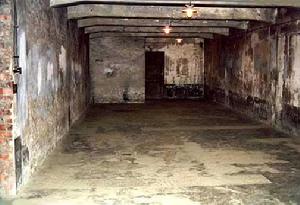納粹毒氣室
Gas chambers were used in the Nazi Third Reich during the 1930s as part of the so-called "public euthanasia program" aimed at eliminating physically and intellectually disabled people, and later the mentally ill. At that time, the preferred gas was carbon monoxide, often provided by the exhaust gas of cars or trucks or army tanks.
Later, during the Holocaust, gas chambers were modified and enhanced to accept even larger groups as part of the Nazi policy of genocide against Jews, and others. In January or February, 1940, 250 Gypsy children from Brno in the Buchenwald concentration camp were used as guinea pigs for testing the Zyklon B (hydrogen cyanide absorbed into various solid substrates)【2】. On September 3, 1941, 600 Soviet POWs were gassed with Zyklon B at Auschwitz camp I; this was the first experiment with the gas at Auschwitz.
Carbon monoxide was also used in large purpose-built gas chambers. The gas was provided by petrol or diesel engines (detailed in the Gerstein Report).【3】 Nazi gas chambers in mobile vans and at least eight concentration camps (see also extermination camp) were used to kill several million people between 1941 and 1945. Some stationary gas chambers could kill 2,500 people at once. Numerous sources record the use of gas chambers in the Holocaust, including the direct testimony of Rudolf Höß, Commandant of the Auschwitz concentration camp【4】.
The gas chambers were dismantled when Russian troops got close, except at Majdanek. The gas chamber at Auschwitz I was rebuilt after the war as a memorial, but without a door in its doorway.
圖片
 納粹毒氣室
納粹毒氣室